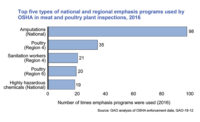Manufacturing News
Local food still raises safety concerns
Auburn University project aims to improve food safety in local products

Auburn University agriculture professor Christy Bratcher uses a wireless scale to record the weight of a heifer. Bratcher, director of Auburn’s Food Systems Institute, is leading a research project to assess the safety of locally produced foods, create educational material and develop a butchery school.
Photo courtesy of: Philip Smith
While the local foods movement has generated excitement among consumers, buying locally processed meats is not necessarily a guarantee that they will be more food safe than large-scale, commercially processed meats. Very small shops may lack the financial resources and food safety training that large companies apply on a day-to-day basis.
Thanks to a grant from the USDA National Institute of Food and Agriculture, Auburn University researchers are addressing the gaps between knowledge and practice in the production and distribution of local and regional goods, with the goal of ensuring a more secure and safe food chain.
Christy Bratcher—lead researcher, College of Agriculture professor and director of the Food Systems Institute—is working to make sure locally produced meat is safe to eat. Bratcher began her research project by going to farms where cattle are raised for commercial harvests and direct sales.
“We looked at E. coli prevalence in addition to feeding, bedding and working chutes, along with environmental swabbing,” Bratcher says. “We collected fecal samples and water samples from any streams or ponds that these animals had access to, and we found higher levels of E. coli in water to which cattle had access, which wasn’t a surprise.”
While the E. coli investigated for Bratcher’s research product are not typically harmful to cattle, certain species are known pathogens to humans.
Bratcher found the biggest problem faced by local producers was keeping their facilities sanitary. Her research colleague for this portion of the project was Manpreet Singh, formerly of Purdue University, and now at the University of Georgia. They looked at federally inspected, small regional facilities, state-inspected very small regional facilities and very small local facilities.
“While all had E. coli positive samples prior to processing, the concern is the overall reduction in the pathogen by the time all of the harvesting steps have been done and the carcass reaches the final chilling step,” says Bratcher. “For the small and very small regional facilities, there was no detectable E. coli at the end of the harvest process, while in the very small local facilities, there were still some positive carcasses.”
Bratcher notes that large production facilities can afford to invest in intervention strategies, such as steam pasteurization cabinets to make sure E. coli and other pathogens aren’t transferred from feces and intestinal contents to the meat.
“Small and very small facilities do not have as many resources, and while there are definitely fairly inexpensive ways to assure a safe and wholesome product, many of the facilities have untrained employees who could use some extra training in processing practices and a clear understanding that their every activity in the processing has a potential to impact the safety of the product for the end consumer,” says Bratcher.
To assist local producers in reducing the amount of E. coli transferred to beef in a harvest facility, Bratcher’s team put together a series of Alabama Cooperative Extension System talks on sanitary design to present to producers and packaging plants. “We gave them suggestions on steps they should take when harvesting an animal to make sure everything is sanitary,” she adds.
Bratcher also partnered with the Auburn University Lambert-Powell Meat Laboratory staff and Regional Extension Agent Alex Tigue to develop a butchery school to train producers on proper sanitary design in facilities and education for processing meat, which is expected to start in 2019.
E. coli not the only culprit
This past summer has produced a large number of multi-state Salmonella outbreaks, which according to the CDC, have not only been caused by consumer food products but also by consumers who keep small flocks of backyard chickens.
While the original intent of Bratcher’s project was to look for the presence of E. coli in beef cattle, she found—while conducting this study—another potential issue, the presence of poultry animals in close proximity to cattle. So Bratcher extended her research to include Salmonella as well.
Bratcher and her researchers found that Salmonella was present on cattle farms where chickens and turkeys were present.
“We found some linkage between the amount of Salmonella that was on these farms and the amount of Salmonella that was in the water, and we also picked up some positive samples where cattle were located,” says Bratcher.
Bratcher’s team looked for ways of transmission of Salmonella from a cow’s GI tract into the meat.
“We found that cattle infected with Salmonella sometimes do not appear sick enough for anyone to realize that they shouldn’t be harvested for food,” says Bratcher. “So we want to find out if there’s anything we can do to reduce the amount of Salmonella in those animals.”
Looking for a reprint of this article?
From high-res PDFs to custom plaques, order your copy today!







